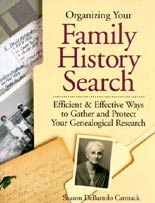I've discovered a great printed resource in Sharon DeBartolo Carmack's Organizing Your Family History Search: Efficient & Effective Ways to Gather and Protect Your Genealogical Research (published 1999 by Betterway Books). My filing system has been needing revamping for a while. For many years, my records have been filed in folders categorized by surname (Midkiff, Robbins), location (Kent Co., Michigan; New York), and interest area (articles and seminar notes on probate records, censuses, etc.). While the location and interest area folders will probably remain the same, the surname folders are getting quite large and unwieldy. In many cases, I have three or four folders of information on the same surname, usually from different sources.
After browsing the Family History Store, I decided to switch to a color-coded system using Ahnentafel numbers as my filing sequence. My father's ancestors will be filed in blue folders, my mother's in red, my father-in-law's in green, and my mother-in-law's in yellow folders (I'm using my own products purchased at Office Depot). Using the recommendations from Sharon's book, every family group or couple that I am researching will have their own folder, marked with "M24/25" or "N16/17," etc. to indicate that this folder contains information on Miriam's ancestors (numbers 24 and 25 on her pedigree chart) or Norm's ancestors (numbers 16 and 17 on his pedigree chart).
Each folder will hold information on the couple's children. If the folder gets too unwieldy, I'll create a folder for each of the couple's married children, marked "M24/25.1" or "N16/17.3", showing that it contains information on the first child of my ancestors whose ahnentafel numbers are 24 and 25, or the third child of Norm's ancestors whose ahnentafel numbers are 16 and 17.
Color-coded family folders, labeled by surname, containing general research information, correspondence, and photographs will still be used, but will be much thinner and easier to manage than if they had all the documents for family members stored in them. Locations and interest areas will continue to be stored in manilla folders. I am also going to use orange folders for my mother's step-father's line and purple folders for my paternal grandmother's adoptive line, as I have done extensive research on these families. Although not biological ancestors, they have greatly influenced what my family is and who I am.
Organizing Your Family History Search is not just about organization of documents and records. A look at the table of contents gives a broad picture:
- Why Genealogists Need to Be Organized
- Creating and Maintaining a Family History Filing System
- Oh No! Not More Files!
- Making Your Research Trip Count
- Packing for Research Trips
- Organizing a Research Project
- There's More to Organize Than Your Research
- Finding Room in Your House for Your Genealogy Stuff
- Organization for Professional Genealogists
- Organizing and Preserving Your Genealogy for the Future

No comments:
Post a Comment